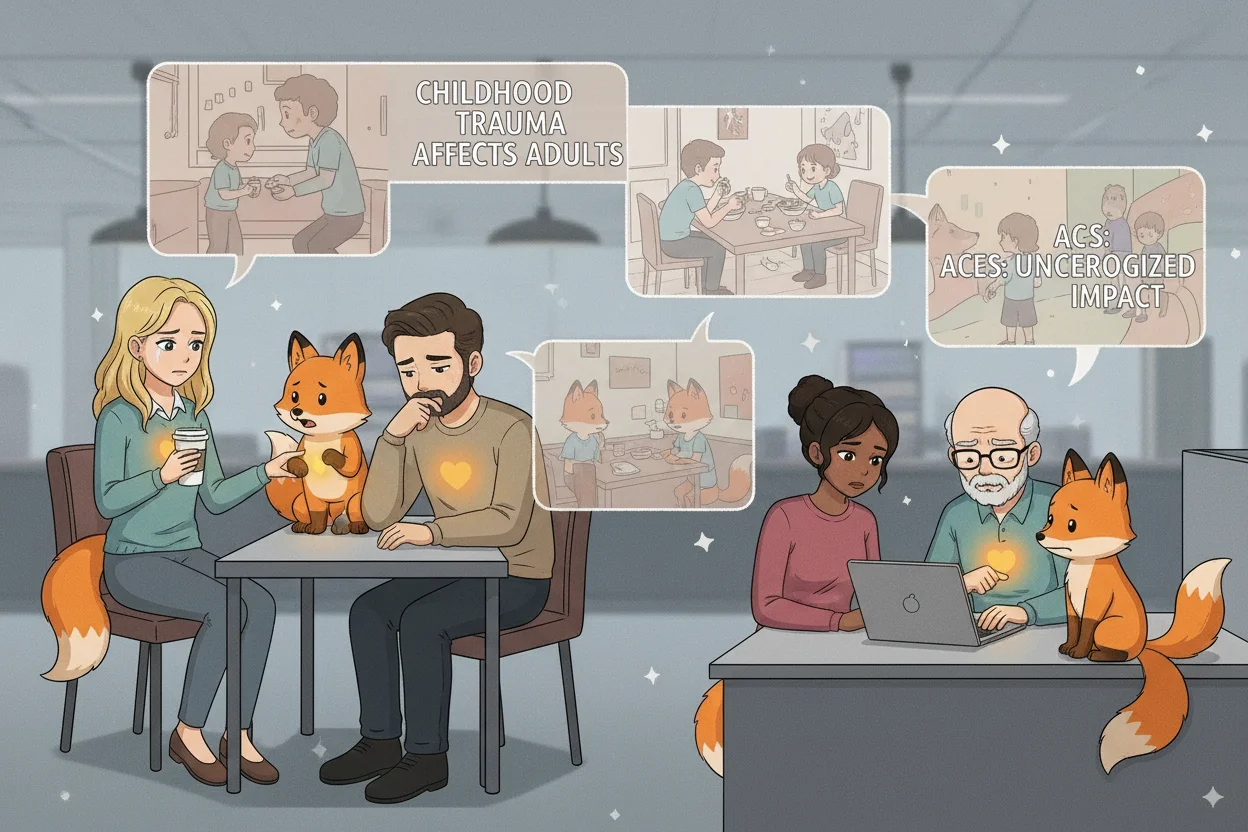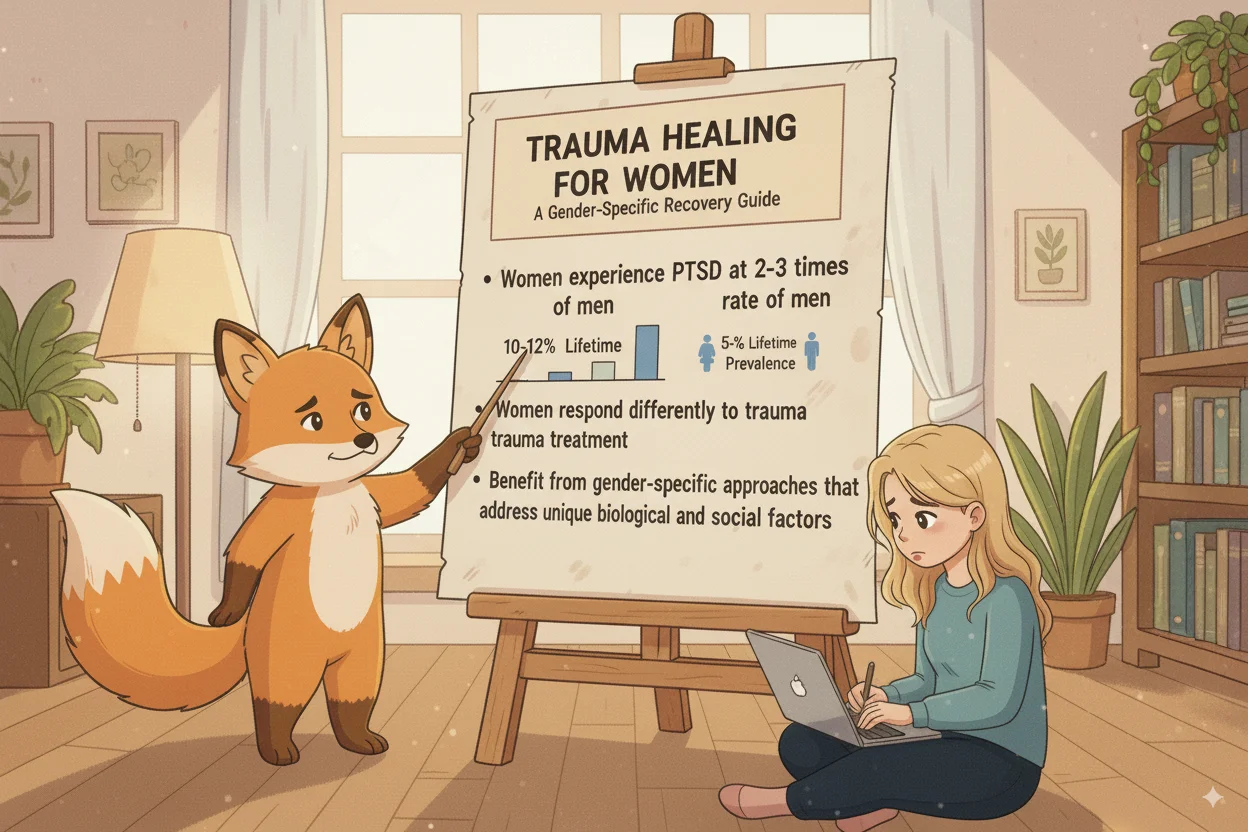
Childhood Trauma Recovery: An Adult Healing Guide
Childhood trauma affects 60% of adults, but healing is possible at any age. Learn evidence-based approaches to recover from early experiences and reclaim your life.
Childhood Trauma Recovery: An Adult Healing Guide
Understanding Childhood Trauma: More Common Than You Think
Childhood trauma affects 2 out of 3 adults, yet many don't recognize its ongoing impact. The Adverse Childhood Experiences (ACEs) study revealed that early trauma significantly increases risk for mental health, physical health, and social problems throughout life.
What Counts as Childhood Trauma?
"Big T" Traumas (Acute Events)
Physical and sexual abuse:
- Any unwanted sexual contact
- Physical violence or severe punishment
- Witnessing domestic violence
- Severe neglect of basic needs
Family dysfunction:
- Parental substance abuse
- Mental illness in household
- Incarcerated family member
- Divorce or separation
"Little t" Traumas (Developmental/Emotional)
Emotional neglect:
- Lack of emotional attunement from caregivers
- Dismissal of feelings or needs
- Emotional unavailability of parents
- Parentification (being forced to act like adult)
Attachment disruption:
- Inconsistent caregiving
- Multiple caregiver changes
- Adoption or foster care experiences
- Early hospitalization or separation
Research finding: Emotional neglect and attachment trauma are often more damaging to development than single-incident traumas.
How Childhood Trauma Shows Up in Adulthood
Emotional Regulation Challenges
Common patterns:
- Intense emotions that feel overwhelming
- Difficulty identifying and expressing feelings
- Either over-emotional or completely numb
- Fear of abandonment alternating with fear of intimacy
The reason: Trauma during critical brain development periods disrupts the formation of emotional regulation circuits.
Relationship Patterns
Insecure attachment styles:
- Anxious: Clingy, fear of abandonment, people-pleasing
- Avoidant: Difficulty with intimacy, emotional distance, hyper-independence
- Disorganized: Chaotic relationship patterns, push-pull dynamics
Trust and boundary issues:
- Either trusting too quickly or not at all
- Difficulty saying no or setting limits
- Attracting or staying in unhealthy relationships
- Self-sabotaging when relationships become too good
Physical and Mental Health Impacts
Increased risk for:
- Depression and anxiety (4x higher risk)
- Autoimmune disorders
- Heart disease and diabetes
- Addiction and substance abuse
- Chronic pain and inflammation
- Early death (reduced life expectancy by 20 years with high ACEs)
The Neuroscience of Childhood Trauma
How Trauma Changes the Developing Brain
Amygdala (fear center): Becomes hyperactive, scanning for threats constantly Hippocampus (memory center): Shrinks, affecting ability to distinguish past from present Prefrontal cortex (executive function): Underdeveloped, making emotional regulation and decision-making difficult
Result: Your brain remains stuck in survival mode, even when you're safe.
The Window of Tolerance
Trauma narrows your "window of tolerance" - the zone where you can handle stress and emotions effectively.
Below the window: Depression, numbness, dissociation, shame Above the window: Anxiety, rage, panic, hypervigilance Within the window: Calm, present, able to think clearly
Recovery goal: Widening your window of tolerance through healing practices.
Evidence-Based Treatments for Childhood Trauma
Complex PTSD Treatment
Unlike single-incident PTSD, childhood trauma often results in Complex PTSD, requiring specialized treatment approaches.
Phase-oriented treatment:
- Stabilization: Safety, grounding, emotional regulation skills
- Trauma processing: Working through specific memories and patterns
- Integration: Rebuilding identity and relationships
EMDR (Eye Movement Desensitization and Reprocessing)
Effectiveness for childhood trauma:
- 77% of multiple-trauma survivors no longer meet PTSD criteria after treatment
- Particularly effective for visual and sensory trauma memories
- Can process trauma without detailed verbal recounting
Adaptation for developmental trauma:
- Longer preparation phase
- Resource building focus
- Addressing developmental deficits
Internal Family Systems (IFS)
Core concept: Different "parts" of your personality developed to protect you during trauma
Common parts:
- Exiles: Wounded child parts carrying pain
- Managers: Parts trying to control environment to prevent further harm
- Firefighters: Parts that act out when exiles get triggered
Goal: Develop relationship with your "Self" - the calm, wise, compassionate core that can heal and lead your parts.
Somatic Approaches
Since childhood trauma is stored in the body, body-based therapies are essential:
- Trauma-informed yoga
- Somatic Experiencing
- Dance/Movement Therapy
- Breathwork practices
Healing Attachment Trauma in Adulthood
Understanding Your Attachment Style
Secure attachment (earned):
- Developed through healing relationships
- Comfortable with intimacy and independence
- Able to communicate needs directly
Anxious attachment:
- Fear of abandonment
- Seeks constant reassurance
- Difficulty being alone
Avoidant attachment:
- Fear of intimacy and dependence
- Prefers emotional distance
- Difficulty expressing vulnerabilities
Disorganized attachment:
- Want close relationships but fear them
- Chaotic relationship patterns
- Often from abuse or severe neglect
Developing Earned Security
Through therapy: Corrective relationship experience with therapist Through relationships: Consciously choosing secure partners and friends Through self-relationship: Becoming secure with yourself through self-compassion
Reparenting Yourself: Healing the Inner Child
What Is Reparenting?
Giving yourself what you needed as a child but didn't receive - safety, validation, unconditional love, appropriate boundaries.
Practical Reparenting Techniques
Inner child dialogue:
- Visualize yourself as a child
- Ask what that child needs
- Provide comfort, reassurance, or protection
- Speak to your inner child with kindness and understanding
Meeting developmental needs:
- Safety needs: Create predictable routines, safe physical environments
- Attachment needs: Develop secure relationships, practice self-compassion
- Exploration needs: Try new experiences, be curious rather than judgmental
- Identity needs: Discover your authentic preferences, values, dreams
Setting healthy boundaries:
- Learning to say no without guilt
- Protecting your time and energy
- Choosing relationships that feel safe and supportive
Breaking Intergenerational Trauma Patterns
Understanding Trauma Transmission
How trauma passes down:
- Parenting behaviors learned from own traumatic childhood
- Unresolved trauma affecting emotional availability
- Genetic and epigenetic changes from trauma
- Family systems that perpetuate dysfunction
Stopping the Cycle
Self-awareness:
- Recognize your triggers and reactive patterns
- Understand how your childhood affects your parenting
- Practice mindful responding rather than automatic reacting
Healing work:
- Address your own trauma before or alongside parenting
- Develop emotional regulation skills
- Learn about child development and attachment
Conscious parenting:
- Provide secure attachment for your children
- Break patterns of abuse, neglect, or emotional unavailability
- Create safety and predictability
Self-Care for Trauma Survivors
Trauma-Informed Self-Care
Traditional self-care advice often doesn't work for trauma survivors. Trauma-informed approaches consider your unique needs and triggers.
Safe self-care practices:
- Start small and build gradually
- Notice what feels genuinely nourishing vs. what you think "should" feel good
- Honor your need for control and choice
- Include practices that help you feel grounded in your body
Building Distress Tolerance
Healthy coping strategies:
- Grounding techniques (5-4-3-2-1 sensory method)
- Breathing exercises
- Movement and gentle exercise
- Creative expression
- Connection with safe people
Warning signs to address:
- Using substances to cope
- Self-harm behaviors
- Isolating for extended periods
- Engaging in risky or dangerous behaviors
Creating Safety in Your Current Life
Physical Safety
- Secure housing with privacy and control
- Financial stability and independence
- Protecting yourself from ongoing trauma or abuse
- Medical and dental care
Emotional Safety
- Relationships with trustworthy people
- Boundaries with unsafe or triggering people
- Therapy or support groups
- Practices that help you self-soothe and regulate emotions
Psychological Safety
- Environments where you can be authentic
- Freedom from constant criticism or judgment
- Ability to express yourself and have opinions
- Protection from gaslighting or manipulation
The Journey of Healing: What to Expect
Early Recovery (Months 1-6)
Focus: Safety and stabilization Common experiences:
- Emotions may feel more intense initially
- Memories and dreams may increase
- Need for extra rest and gentle self-care
- Building trust in therapy relationship
Middle Recovery (Months 6-18)
Focus: Processing trauma and grief Common experiences:
- Grieving the childhood you didn't have
- Anger emerging as you recognize injustices
- Relationship changes as you grow
- Developing new coping skills
Later Recovery (18+ months)
Focus: Integration and growth Common experiences:
- Greater emotional stability
- Improved relationships
- Sense of purpose and meaning
- Post-traumatic growth and resilience
Building Your Support System
Professional Support
Trauma-informed therapists: Specialized training in childhood trauma Support groups: Others with similar experiences Medical team: Address physical health impacts Spiritual support: If meaningful to you
Personal Support
Safe relationships: People who respect boundaries and provide emotional support Chosen family: Close friends who function like healthy family Mentors: People who model healthy relationships and coping Community: Groups or organizations aligned with your values
Hope and Post-Traumatic Growth
Research shows trauma survivors often develop:
- Greater empathy and compassion
- Stronger, more authentic relationships
- Increased appreciation for life
- Spiritual growth and meaning-making
- Resilience and coping skills
- Desire to help others heal
Remember: Healing from childhood trauma is possible at any age. Your brain remains capable of change throughout your life. While you can't change what happened, you can change how it affects your present and future.
The journey isn't linear, and healing doesn't mean forgetting or minimizing what happened. It means developing the skills to live fully despite your history, and often, to use your experience to create meaning and help others.
Did this article help you on your healing journey? I'd love to hear from you!
Send Sisi a Message